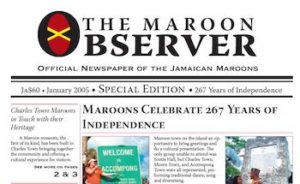
Maroon Newspaper
*On March 31, 1600, the Maroon community was affirmed. The Maroons are descendants of Africans who participated in the French and Spanish transatlantic slave trade. They inhabit the Caribbean. Maroon was derived via French from the Spanish word cimarrón, meaning "wild" or "untamed."
This word usually referred to runaways, castaways, or the shipwrecked; those marooned probably would never return. When the British invaded Jamaica in 1655, most Spanish colonists fled. Many of their African slaves escaped and, together with free Blacks and Mulattoes, former slaves, and some native Taíno, merged into ethnically diverse groups in the Jamaican interior. Some created palenques or stockade mountain farms similar to the Palmares communities in Brazil.
Maroon farms were first at Lluidas Vale, in modern-day St Catharine Parish, under Juan de Bolas. Toward the western end of Cockpit Country were the ‘Varmahaly or Karmahaly Negroes’ under the leadership of Juan de Serras; a third group was active in the region of Porus, in modern Manchester Parish; and there was possibly a fourth in the Blue Mountains. During the first decade of British rule, these groups were active on behalf of the Spanish. But, as it became increasingly apparent that the British would hold their conquest, the group run by de Bolas changed its position. Faced with discovery and defeat in 1659, de Bolas allied with the British and guided their troops on a raid, resulting in the Spanish's final expulsion in 1660.
In exchange, in 1663, Governor Lyttleton signed the first maroon treaty, granting de Bolas and his people land on the same terms as British settlers. The white colonial authorities paid the men of de Bolas to hunt the supporters of de Serras and recent runaways. However, de Bolas was killed in an ambush, probably by maroons belonging to de Serras. While the maroons belonging to de Bolas disappeared from history, the English authorities failed to subdue the Karmahaly Maroons. The other maroon groups remained independent in the mountainous interior of Jamaica, surviving by subsistence farming and periodic raids of plantations. These initial maroon groups dwindled, migrating or merging with settlers. Others may have merged to form the nucleus of what would later be called the Windward Maroons.
Over time, runaway slaves increased the maroon population of the Jamaican mountainous interior. In the 1670s and 1680s, Sir Henry Morgan, slave plantation owner and lieutenant-governor of Jamaica, led three campaigns against the Karmahaly Maroons of de Serras. Morgan succeeded against the Maroons, who withdrew further into the Blue Mountains, where they could stay out of the reach of Morgan and his forces. Between 1673 and 1690, there were several major slave uprisings prompted by newly arrived, highly militarized Fante or Coromantee groups from Cape Coast and the Ashanti Empire. On July 31, 1690, a rebellion involving 500 slaves from the Sutton estate in Clarendon Parish led to the formation of Jamaica’s most stable and organized maroon group. Although some were killed, recaptured, or surrendered, more than 200, including women and children, remained free after the rebellion ended.
They established an Ashanti-style polity in the western parts of the Cockpit Country, notably Cudjoe's Town. They incorporated outsiders only after newcomers had satisfied a strict probationary period. When they agreed to peace, the Eastern Maroons' leader was Quao. In the wilder parts of eastern Jamaica, the Windward Maroons comprised separate, highly mobile, and culturally mixed groups. Early on, the Jamaican governors considered their settlements an impediment to British interior development. They ordered raids on the Maroon settlements in 1686 and 1702, to little effect.
By about 1720, a stronger Windward community had developed around the culturally Africanized group of three villages known as Nanny Town, under the spiritual leadership of Queen Nanny, an Ashanti woman. She was known for her exceptional leadership skills, especially in guerrilla warfare during the First Maroon War. One tactic particular to the Jamaican Maroons involved the art of camouflage using plants. Her remains are reputedly buried at "Bump Grave" in Moore Town, the main town of the Windward Maroons concentrated in and around the Rio Grande valley in the northeastern parish of Portland. Queen Nanny, also known as Granny Nanny (died c. 1750s), is the only woman honored as one of Jamaica's National Heroes. She has been immortalized in songs and legends.
In the 21st century, the maroons in Jamaica are, to a small extent, autonomous and separate from Jamaican culture. Those of Accompong have preserved their land since 1739. The isolation used to their advantage by their ancestors has resulted in their communities being amongst the most inaccessible on the island. The four official maroon towns still in existence in Jamaica are Accompong Town, Moore Town, Charles Town, and Scott's Hall. They held lands allotted to them in the 1739–1740 treaties with the British. These maroons still maintain their traditional celebrations and practices, some of which have West African origins.
Native Jamaicans and island tourists are allowed to attend many of these events. Others considered sacred are held in secret and shrouded in mystery. Singing, dancing, drum-playing, and preparing traditional foods are central to most gatherings. In their most significant town, Accompong, in the parish of St. Elizabeth, the Leeward Maroons have a vibrant community of about 600. Tours of the village are offered to foreigners. They hold a large festival annually on January 6 to commemorate the signing of the peace treaty with the British after the Maroon War.
Moore Town, located between the Blue Mountains and the John Crow Mountains in Portland Parish, was relisted on the UNESCO Representative List of the Intangible Cultural Heritage of Humanity in 2008 for its maroon heritage, particularly music. In 2009, Ferron Williams was elected as Colonel-in-Chief of Accompong. This position leads the Maroon Council, with whom the Colonel shares executive responsibilities. On April 16, 2015, Colonel Williams was elected to his second term in office. Richard Currie is now Colonel-in-Chief of Accompong after the election held in February 2021.